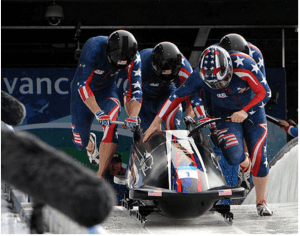Welcome to Part Two of our journey through time, learning how the Internet has evolved and remembering the effect that it has had on our lives.

In the first part, we saw the birth of the Internet in the USA. We learned some of the protocols that are fundamental to how the Internet works.
By 1989, the Internet works across countries, including Australia, Mexico, Japan, and many European countries.
This sets the stage for the biggest revolution in the history of the Internet, one with very humble beginnings and snowballing benefits: the World Wide Web.
But first there is another story to tell: the backstory of Sir Timothy Berners-Lee.
Tim Berners-Lee is born in 1955 as the son of two mathematicians, Mary Lee Woods and Conway Berners Lee. His parents are part of the team who programmed the world’s first commercial, stored-program computer, the Manchester University “Mark 1.”
He is fortunate enough to grow up in an environment where he can learn what computers are and gain an understanding of how they work from an early age.
He realizes how computers could be much more powerful if only there was a way to program them to link otherwise unconnected information. This thought stays with him during his years at Oxford University, where he studies physics.
In 1980 he joins CERN, the European Particle Physics Laboratory in Geneva. Initially, he is almost overwhelmed with information: there are 10,000 employees here and so many different computers and projects.
To manage all of these relationships and help himself to remember them all, in his spare time he begins an experimental project: writing a small program using Pascal.
He calls his project Enquire, a name inspired by the Victorian book, Enquire Within Upon Everything.
This book provides encyclopedic information on many diverse topics. With subjects such as etiquette, parlour games, cake recipes, laundry tips, and first aid all covered, this book broke the mould for what a book should be and was a bestseller in its day.
Tim reads this book as a child and feels it is “a portal to a world of information.”
Tim is satisfied with the results of Enquire and begins to think bigger. Much bigger! “Suppose all the information stored on computers everywhere were linked,” he muses.
He also notes that retrieving information from the computers is much more challenging than it needs to be.
Each computer has its own set of information. Not only do the CERN employees need to log into many different computers, but they are also often required to learn how to use a different program for each computer they wish to retrieve information from.
He sees many developers arrive at CERN and attempt to sell documentation systems to researchers. But they receive a hostile reception, because all of the systems they are attempting to sell require the researchers to reorganise and constrain their work to fit the limitations of those systems.
From witnessing these conversations, Tim learns that any system containing common rules that work for everyone would mean having next to no rules at all!
Over the next few years, he learns more about the idea of Hypertext, which Ted Nelson presents in his book Literary Machines. He comes to believe that this idea holds the potential to change computing forever.
It is also necessary, Tim believes, that the system be completely decentralized. In 1988, he speaks to his boss, Mike Sendall, about his idea and is asked to write up a proposal.
1989
Tim writes a document called “Information Management: A Proposal.” It discusses the information access problems that he has identified and proposes the idea of replacing the current system with linked information systems.
Tim sends it off to Mike Sendall and also Mike’s boss. While he is waiting for their feedback, he floats the ideas to several other colleagues and is met with a “lacklustre” response.
There is no official response for his proposal, but the more that Tim experiments with the Internet, the more he becomes convinced of the importance of his idea.
1990
Tim decides to name the project the World Wide Web. He reformats his proposal, puts a new date of May 1990 on it, and re-submits it.
Later this year, he asks Mike Sendall for investment in a NeXT computer. Mike agrees and says, “Once you get the machine, why not try programming your hypertext thing on it?”
While starting this new project, he faces many detractors, but is buoyed by the support of one colleague: Robert Cailliau, a Belgian-born engineer with a love of elegant solutions.
According to Tim, Robert could be “driven mad by the incompatibility of power plugs.”. Robert immediately sees the potential of this project for evolving computer systems away from the mass of conflicting protocols that are a part of everyday life.
In September, Tim and Robert travel to the European Conference of Hypertext Technology to pitch the idea and hopefully find a company they can buy a solution from.
They find that many attendees cannot fully understand what the idea is all about. Tim hears that a better design is to have a central link database; otherwise, the system will have broken links.
Soon after arriving home, Tim realizes that he will need to build the Web himself and begins this in October. By December, it is working, with a new Hypertext Markup Language (HTML), a simplified version of the Standard Generalized Markup Language (SGML).
However, it is only working on one platform: the NeXT. Nicola Pellow, a maths undergraduate from England, is hired to help out.
Tim adds the programming necessary to work with the file transfer protocol. Suddenly, Internet newsgroups and articles are available as web pages, making a huge amount of information on the Internet also accessible on the Web.
1991
Although Tim has a desire to get the Web working on IBM compatible PCs, due to limited resources he decides to stick with the NeXT system for the time being. The WorldWideWeb browser is installed onto some of his colleagues’ NeXT computers in March.
Because the project is being funded by CERN, the first database to be added to the Web is the CERN telephone book.
The first web server outside of CERN is created at the Stanford Linear Accelerator (SLAC) in Palo Alto.
To combat misunderstanding of this new technology and explain why it is different, Tim describes it as being like a market economy: anybody can trade with anybody, and they don’t need to go to a market square to do it. All they need is a few rules that everyone must agree to, such as the currency used and the rules of fair trading.
For the Web to become a success, people must share data. Tim has found that the existing Internet protocols don’t make it easy enough for anyone to share data freely.
He writes the HyperText Transfer Protocol (HTTP), designing it to be quick enough to fetch a resource in about a tenth of a second. This is much faster than the File Transfer Protocol (FTP), but as huge amounts of information are already available via FTP, it is based to support this protocol as well.
The key component is the Universal Resource Identifier (URI), which tells the browser where to go to find any resource. The first few letters of the URI address specify the protocol to use, and Tim designs it to support both HTTP and FTP. Two other protocols, Gopher and WAIS, are proving much more popular than HTTP, so Tim decides to support these as well.
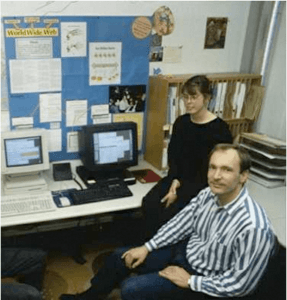
In order to get continued funding for the World Wide Web at CERN, Robert and Tim decide to market it as a way to extend a user’s existing documentation system, arguing that it helps people to send and access information.
They write a paper titled “Hypertext at CERN,” but it does not generate much interest at all.
In June, the first INET Conference is held in Copenhagen and is attended by 385 participants from 58 countries.
At the closing session, Vint Cerf announces the founding of the Internet Society, based on a document signed by himself, Bob Kahn, and Lyman Chapin. This document states that the society will “provide assistance and support to groups and organizations involved in the use, operation, and evolution of the Internet.”
In August, Tim releases the WorldWideWeb browser for NeXT, the line mode browser that Nicola wrote, and the HTTP server outside of CERN.
A trickle of bug reports and feature requests come in. Then, Tim begins to receive messages of praise and even source-code contributions from other countries! Page hits on the CERN website, info.cern.ch, are reaching around one hundred per day.
Nicola Pellow leaves the project to finish her studies in August. In September, Jean-Francois Groff arrives and finds Tim is in the middle of rewriting his Objective-C code into the more portable C language. The result is libwww, short for Library World Wide Web.
In December, Robert and Tim fly to San Antonio, along with their NeXT computer and modem, for the Hypertext ‘91 conference. They find they are the only attendees doing anything related to the Internet.
Over at Menlo Park, California, Sun Microsystems engineer Patrick Naughton joins a new project with James Gosling and Mike Sheridan. This is named the “Green Project,” and the purpose is “to anticipate and plan for the ‘next wave’ in computing.”
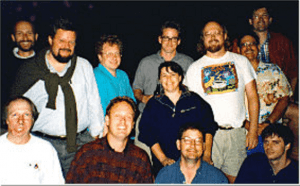
Also this month, the High Performance Computing Act, also known as the Gore Bill, is passed.
1992
Robert and Tim know that more developers are needed to create a better web browser, and that they aren’t available at CERN.
Robert flies to Helsinki University to meet students interested in building a web browser for their combined master’s project. As their department initials are OTH, they call the browser Erwise, so that it spells “otherwise.” It is released in April.
Next month, Pei-Yuan Wei at the University of California, Berkeley, releases a test version of his ViolaWWW browser to demonstrate the power of the Viola programming language. For the first time, Unix users can now access the Web.
In June, Tim meets members of the Internet Engineering Task Force (IETF) to discuss how to standardise the addressing scheme, HTTP and HTML. Tim argues for the name Universal Document Identifier, but the name is unpopular with the IETF so he compromises on URI: Uniform Resource Identifier, and a URI Working Group is formed.
Also this summer, the Sun Microsystems “Green Team” emerge from their office with a working demo: an interactive, handheld, home-entertainment device controller with an animated touchscreen user interface. This uses a new programming language that James Gosling created called Oak, named after the Oak tree outside his office window.
1993
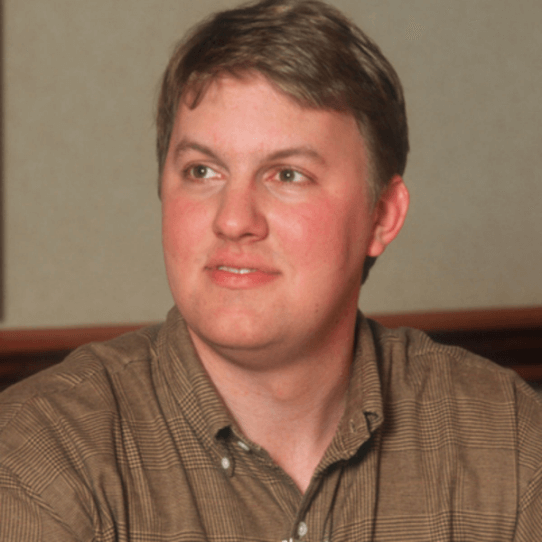
Marc Andreessen, a student at the National Center for Supercomputing Applications (NCSA), works with staff member Eric Bina on the Mosaic browser. This is financed by funds from the High Performance Computing Act.
Marc announces the project in January and releases a first preview version over the web in February. Even at this very early stage, it is easy to install and use and provides point and click access to the Web.
Meanwhile, Lou Montulli, a student at the University of Kansas, takes the first version of the Lynx hypertext browser and ports it to the web. In March, he releases it as Lynx 2.0.
Also this month, the University of Minnesota announces the licence fee for companies using its gopher server software. Tim is asked by members of the IETF if CERN might also introduce a licence fee. They tell him that they would recommend against use of the Web if this were to happen.
In April, CERN agrees to Tim’s request to make the web protocol freely available in the public domain.
Meanwhile, J. Allard, a junior Program Manager in Microsoft’s Network Operating Systems division, is growing increasingly frustrated with his lack of success in convincing senior management of the importance of the Internet and watching other companies take the lead.
On his own initiative, he begins an unsanctioned project to develop Microsoft’s first Internet server to link the company to other Internet sites. This quickly becomes one of the most used sites on the Internet.
NCSA Mosaic version 1.0 for Windows is released in November.
In December, the media publishes major news articles on the first Web-based project of the European Union, Webcore, for disseminating technological information throughout the former Soviet Bloc countries.
Also this year, Digital Subscriber Line (DSL) becomes a standard in the United States, paving the way for much faster Internet connections.
1994
Microsoft Plans to Enter the Market; Mosaic Communications Founded
In January, J. Allard still strongly feels that Microsoft doesn’t understand the importance of the Internet. He writes the memo Windows: The Next Killer Application on the Internet” to leaders at Microsoft.
This document provides a detailed look at the various Internet technologies available at the beginning of 1994, and their rise in popularity up until then. The World Wide Web is listed in the section “Information Discovery and Retrieval (Second Generation Tools)” along with Archie and WAIS, and shows the number of Web Servers has increased rapidly since NCSA Mosaic was released.
Allard says that although the Mosaic browser is available for Windows, “the current implementation is considerably weaker than its Unix counterpart.” He recommends a three-phase approach for participating in the development of the Internet: Embrace, Extend, and Innovate. The end goal is for Windows to become “the global infostructure explorer.”
Included in the list of recipients for this memo is Steven Sinofsky, Bill Gates’ Technical Assistant.
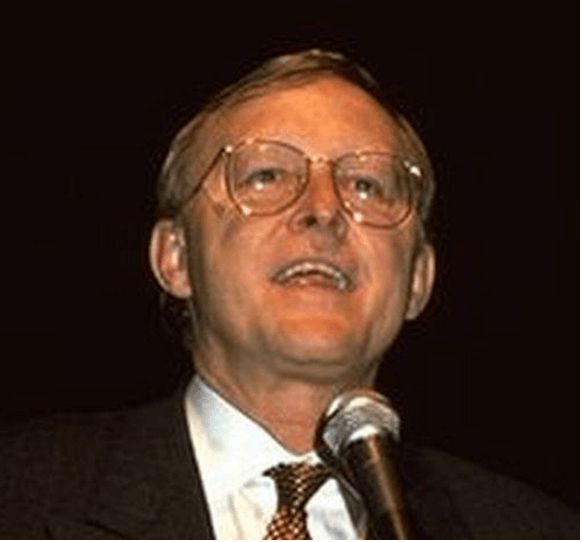
In February, Steven sees the popularity of the Internet and email among students while visiting Cornell University. Impressed by the possibilities of the Internet, Sinofsky writes an enthusiastic memo to Gates and his technical staff saying, “Cornell is wired.”
Meanwhile, Marc Andreessen has graduated and is living in California when he receives an e-mail from Jim Clark. Jim is a businessman who founded Silicon Graphics but had recently left. Jim proposes that they found a new company together.
Jim previously worked with Nintendo CEO Hiroshi Yamauchi and jointly announced “Project Reality” with Nintendo. He believes that they can sell Nintendo their Web technology. They write up a 20-page concept pitch for an online gaming network feature for the upcoming Nintendo 64 console.
They also hire Lou Montulli, the core Mosaic development team from NCSA, and several developers from Silicon Graphics.
On 4th April, Mosaic Communication Corporation is founded, and as a deal with Nintendo has not been agreed, they decide to pursue the browser market.
Just two days after this new company is founded, J. Allard, Steven Sinofsky, and 18 other Microsoft employees attend a daylong retreat and discuss the future effect of the Internet on the computer software business.
Sinofsky distributes a 300-page Internet briefing document to the attendees.
Russell Siegelman is there and is heading up an online services project codenamed “Marvel.” Allard argues that Marvel should be based on open Web standards.
Russell is focused on beating AOL, which is offering a proprietary consumer online service. He disagrees, saying the technology should be proprietary.
What is agreed, though, is that the next version of Windows, codenamed “Chicago,” should include some sort of software for accessing the Web.
Shortly after, Microsoft meets with Spyglass Inc. to discuss licensing the Spyglass browser for use in Windows.
First International World Wide Web Conference
In May, the first International Conference on the World Wide Web is held at CERN in Geneva and dubbed by reporters as the “Woodstock of the Web.” In the closing speech, Tim says that web developers, like scientists, need to be ethically and morally aware of their actions.
Sun Microsystems Targets the World Wide Web
The Oak programming language has been renamed to Java to avoid a trademark infringement, and a deal with Cable TV companies has fallen through. In June, the team decides to re-target the platform for the Web. Patrick Naughton writes the WebRunner browser, named after the movie Blade Runner.
W3C
In October, Tim Berners-Lee founds the World Wide Web Consortium (W3C) at the Massachusetts Institute of Technology, in collaboration with CERN. Full annual membership is available for $50,000 or the same benefits are available for $5,000 if the company has annual revenues of less than $50m.
Mosaic Communication Corp insists on paying the full $50,000 despite qualifying for the reduced rate because of its belief that it is a big company. They release Mosaic Netscape 0.9. It is developing a new protocol called Secure Sockets Layer and plans to include this in a future version of the browser.
In November, both Microsoft and Mosaic Communications Corp attend the Comdex trade show to promote their products. Microsoft announces the Microsoft Network (MSN).
Jim Clark announces their company name is changing to Netscape Communications Corporation. This is due to NCSA suing the company for naming it after their Mosaic software.
In December, the first W3C meeting is held and the need to standardise HTML is discussed. To expedite the process, the attendees agree that the W3C will seek to provide recommendations rather than exact standards.
The next day, Netscape Navigator 1.0 is released for Microsoft Windows, X Windows on Unix, and Apple Macintosh.
Unlike other commercial products which are sold in the store, Netscape Navigator is following the model of other web software and making it available for free over the Internet. The business plan is to dominate the market first and then monetize later via adverts on the Netscape website and a paid premium version of the software.
The day after that, CERN announces that it in order to fund the building of the Large Hadron Collider, it can no longer support the W3C.
Retrospective
At the beginning of this story, the web is nothing more than a big dream. Tim Berners-Lee has no idea whether his project will be successful or end in disaster. He just gives it his best shot.
“A group of individuals holding a common dream and working together at a distance brought about a great change.” — Tim Berners-Lee, Weaving the Web
Whether you are beginning a small project or creating your own company, you can draw inspiration from Sir Timothy and his bobsleigh metaphor. When you are first starting, a huge effort is required just to get any movement at all.
But once this work is done, it begins to get easier. Things start to move by themselves and can move very quickly. At this point, you don’t need to keep pushing; you just need to get in and steer.
“The people of the Internet built the Web, in true grassroots fashion.” -—Tim Berners-Lee, Weaving the Web
But this is not the story of just one man. Many others are involved in the success of the World Wide Web—some are mentioned in this article, and I apologise to the many others left uncredited. There are too many to mention in full, but you know who you are.
History is full of small, forgettable events that in the years ahead, turn out to have massive impact. One example of this is the role that J. Allard, who is today known more for his work on the XBox, plays in determining who wins the lion’s share of the browser market.
Like we saw with Ray Tomlinson in Part One, the young J. Allard is someone who understands that combining a smart idea with the risky strategy of acting entirely on your own initiative might actually pay off well for both himself and his employer.
In the early years of the Web, much of the progress is made by students and hobbyists experimenting and learning from one another.
But as we close the curtain on this act, the Web has become big business. The stage is set for Netscape Communications, Sun Microsystems, and Microsoft to slug it out with each other.
Join me in Part Three for the First Browser War.

